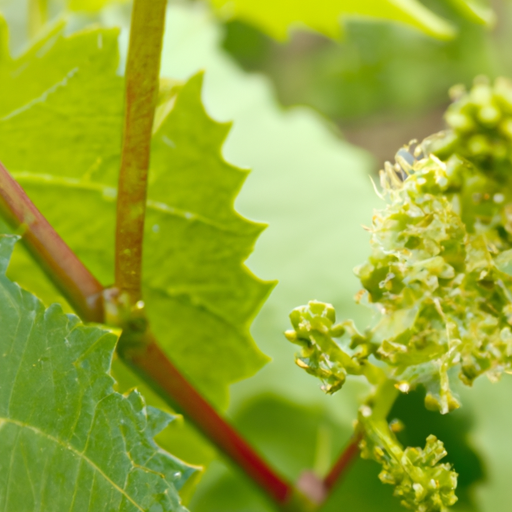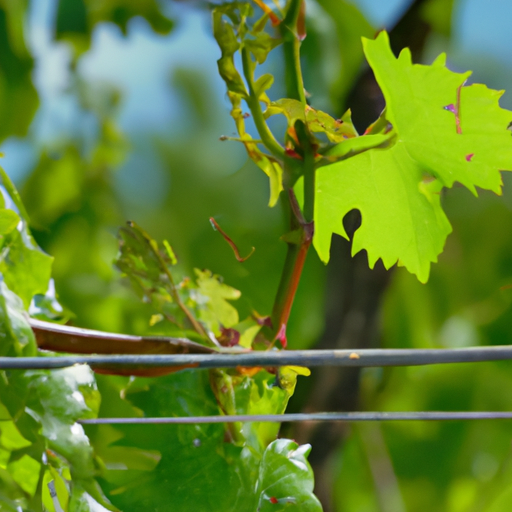
The Importance of Grape Flower Timing in Vineyard Harvest
The timing of grape flower development plays a crucial role in determining the success of a vineyard harvest. Grapevines are perennial plants that rely on the proper timing of their flowering stage to ensure the production of healthy and abundant fruit. This article will explore the importance of grape flower timing in vineyard harvest and how it can impact the overall quality of the grapes.
Grapevines typically go through a series of growth stages throughout the year, with flowering being a critical phase in their life cycle. Flowering usually occurs in the spring, and the timing of this event can vary depending on various factors such as climate, grape variety, and vineyard management practices. The timing of grape flower development is crucial because it determines when pollination occurs, which ultimately affects fruit set and grape yield.
When grape flowers bloom too early, they are at risk of being damaged by late spring frosts. Frost can kill the delicate flowers, leading to poor fruit set and reduced grape yield. On the other hand, if grape flowers bloom too late, they may not have enough time to fully develop and ripen before the onset of winter. This can result in underripe grapes with lower sugar levels and less desirable flavors.
To ensure optimal grape flower timing, vineyard managers often employ various techniques. One common practice is the use of wind machines or heaters to protect the vines from late spring frosts. These machines help circulate warm air, preventing frost from settling on the flowers and causing damage. Additionally, vineyard managers may also use cover crops or mulch to regulate soil temperature and moisture levels, which can influence the timing of grape flower development.
Another factor that can impact grape flower timing is the pruning and leafing practices in the vineyard. Pruning is the process of removing excess vine growth to control vine vigor and promote fruit production. The timing and severity of pruning can influence the timing of grape flower development. Pruning too early can delay flowering, while pruning too late can result in early flowering. Finding the right balance is crucial to ensure optimal grape flower timing.
Leafing, or the removal of excess leaves, is another practice that can affect grape flower timing. Leaves play a vital role in photosynthesis, providing the energy needed for grape development. However, excessive leaf growth can shade the grape clusters, preventing them from receiving enough sunlight for proper ripening. By strategically removing some leaves, vineyard managers can expose the grape clusters to more sunlight, promoting earlier and more uniform flowering.
In conclusion, the timing of grape flower development is of utmost importance in vineyard harvest. It determines when pollination occurs, which affects fruit set and grape yield. Vineyard managers employ various techniques such as the use of wind machines, pruning, and leafing to ensure optimal grape flower timing. By carefully managing these factors, vineyard managers can maximize the quality and quantity of their grape harvest.
How Leafing Affects Grapevine Growth and Harvest

Grapevine growth and harvest are influenced by various factors, including grape flower timing and leafing. Leafing, in particular, plays a crucial role in the overall development of grapevines and ultimately affects the quality and quantity of the harvest. Understanding how leafing affects grapevine growth and harvest is essential for vineyard owners and winemakers to optimize their production.
Leafing refers to the process of leaves emerging from the buds of grapevines. It typically occurs in the spring, as the weather becomes warmer and more conducive to plant growth. The timing of leafing is influenced by several factors, including the grape variety, climate, and vineyard management practices. Early leafing can be advantageous for grapevines as it allows for a longer growing season, which can result in increased sugar accumulation and improved fruit quality.
One of the primary benefits of leafing is the increased photosynthetic capacity of the grapevine. Photosynthesis is the process by which plants convert sunlight into energy, and it is essential for the growth and development of grapevines. The leaves of grapevines are the primary site of photosynthesis, and a greater leaf area can lead to increased photosynthetic activity. This, in turn, can result in enhanced sugar production and improved grape quality.
Leafing also plays a role in regulating the vine’s vegetative growth. When grapevines leaf out early, they tend to have more vigorous vegetative growth. This can be beneficial in certain situations, such as when establishing new vineyards or when trying to fill in gaps in the canopy. However, excessive vegetative growth can also be detrimental to grapevine health and productivity. It can lead to increased shading within the canopy, which can reduce the amount of sunlight available for photosynthesis. Additionally, excessive vegetative growth can make the vine more susceptible to diseases and pests.
Another important aspect of leafing is its impact on grapevine microclimate. The leaves of grapevines provide shade and help regulate temperature within the canopy. This can be particularly important in hot climates, where excessive heat can negatively impact grape quality. By leafing early, grapevines can create a more favorable microclimate, reducing the risk of sunburn and heat stress on the fruit.
In addition to the timing of leafing, the density of leaves within the canopy also affects grapevine growth and harvest. A dense canopy can provide more shade, reducing the risk of sunburn and heat stress. However, a dense canopy can also limit air circulation, increasing the risk of disease development. Finding the right balance between leaf density and air circulation is crucial for optimizing grapevine health and productivity.
In conclusion, leafing plays a significant role in grapevine growth and harvest. The timing of leafing can influence the length of the growing season and the quality of the fruit. Additionally, leafing affects photosynthetic capacity, vegetative growth, microclimate, and disease susceptibility. Vineyard owners and winemakers must carefully manage leafing to optimize grapevine health and productivity. By understanding the impact of leafing on grapevine growth and harvest, they can make informed decisions to maximize the quality and quantity of their grape harvest.
Understanding the Impact of Grape Flower Timing and Leafing on Vineyard Harvest
Grapes are a key component in the production of wine, and the timing of their flowering and leafing plays a crucial role in determining the quality and quantity of the harvest. Understanding the impact of grape flower timing and leafing on vineyard harvest is essential for vineyard owners and winemakers alike.
The timing of grape flowering is influenced by various factors, including climate, soil conditions, and grape variety. Flowering typically occurs in the spring, and it is a critical stage in the grapevine’s life cycle. During this time, the grapevine produces flowers that eventually develop into berries. The timing of flowering is crucial because it determines the length of the growing season and the ripening period.
Early flowering can be advantageous in regions with shorter growing seasons, as it allows the grapes to have more time to ripen before the onset of colder weather. On the other hand, late flowering can be beneficial in regions with longer growing seasons, as it can help to avoid late spring frosts that can damage the flowers and reduce the crop yield.
Leafing, or the emergence of leaves on the grapevine, also plays a significant role in vineyard harvest. Leaves are responsible for photosynthesis, the process by which plants convert sunlight into energy. The timing of leafing affects the grapevine’s ability to produce sugars, which are essential for the development of flavors and aromas in the grapes.
Early leafing can be advantageous in cooler regions, as it allows the grapevine to capture more sunlight and produce sugars more efficiently. This can result in grapes with higher sugar content and better flavor profiles. In warmer regions, however, early leafing can lead to excessive sugar accumulation, which can negatively impact the balance and quality of the grapes.
Late leafing, on the other hand, can be beneficial in warmer regions, as it can help to delay sugar accumulation and maintain acidity levels in the grapes. This can result in wines with better balance and freshness. In cooler regions, late leafing can be problematic, as it may not allow the grapes enough time to ripen fully before the onset of colder weather.
The impact of grape flower timing and leafing on vineyard harvest is not limited to the quality of the grapes. It also affects the quantity of the harvest. Early flowering and leafing can lead to larger crop yields, as the grapevine has more time to develop and produce berries. Late flowering and leafing, on the other hand, can result in smaller crop yields, as the grapevine has less time to develop and produce berries before the onset of colder weather.
In conclusion, the timing of grape flower timing and leafing has a significant impact on vineyard harvest. It affects the quality and quantity of the grapes, as well as the overall balance and flavor profile of the resulting wines. Understanding these impacts is crucial for vineyard owners and winemakers, as it allows them to make informed decisions regarding vineyard management and harvest timing. By carefully considering the timing of grape flower timing and leafing, vineyard owners and winemakers can optimize the quality and quantity of their harvest and produce wines of exceptional quality.






